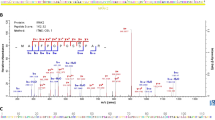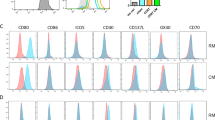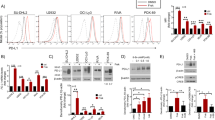Abstract
Toll-like receptor 9 (TLR9) recognizes microbial DNA containing unmethylated cytosyl guanosyl (CpG) sequences, induces innate immune responses, and facilitates antigen-specific adaptive immunity. Recent studies report that in addition to stimulating innate immunity, TLR9 ligands induce apoptosis of TLR9 expressing cancer cells. To understand the mechanism of TLR9-induced apoptosis, we compared the effects of CpG containing oligodeoxynucleotides (CpG ODN) on a mouse B-cell lymphoma line, CH27, with those on mouse splenic B cells. CpG ODN inhibited constitutive proliferation and induced apoptosis in the CH27 B-cell lymphoma line. In contrast, CpG ODN-treated primary B cells were stimulated to proliferate and were rescued from spontaneous apoptosis. The induction of apoptosis required the ODNs to contain the CpG motif and the expression of TLR9 in lymphoma B cells. A decrease in Bcl-xl expression and an increase in Fas and Fas ligand expression accompanied lymphoma B-cell apoptosis. Treatment with the Fas ligand-neutralizing antibody inhibited CpG ODN-induced apoptosis. CpG ODN triggered a transient NF-κB activation in the B-cell lymphoma cell line, which constitutively expresses a high level of c-Myc, while CpG ODN induced sustained increases in NF-κB activation and c-Myc expression in primary B cells. Furthermore, an NF-κB inhibitor inhibited the proliferation of the CH27 B-cell lymphoma line. Our data suggest that the differential responses of lymphoma and primary B cells to CpG ODN are the result of differences in NF-κB activation. The impaired NF-κB activation in the CpG ODN-treated B-cell lymphoma cell line alters the balance between NF-κB and c-Myc, which induces Fas/Fas ligand-dependent apoptosis.
This is a preview of subscription content, access via your institution
Access options
Subscribe to this journal
Receive 12 digital issues and online access to articles
$119.00 per year
only $9.92 per issue
Buy this article
- Purchase on Springer Link
- Instant access to full article PDF
Prices may be subject to local taxes which are calculated during checkout








Similar content being viewed by others
References
Janeway CA Jr, Medzhitov R . Innate immune recognition. Annu Rev Immunol 2002; 20: 197–216.
Akira S, Takeda K, Kaisho T . Toll-like receptors: critical proteins linking innate and acquired immunity. Nat Immunol 2001; 2( 8): 675–680.
Cardon LR, Burge C, Clayton DA, Karlin S . Pervasive CpG suppression in animal mitochondrial genomes. Proc Natl Acad Sci U S A 1994; 91( 9): 3799–3803.
Krieg AM, Yi AK, Matson S, Waldschmidt TJ, Bishop GA, Teasdale R et al. CpG motifs in bacterial DNA trigger direct B-cell activation. Nature 1995; 374( 6522): 546–549.
Hornung V, Rothenfusser S, Britsch S, Krug A, Jahrsdorfer B, Giese T et al. Quantitative expression of Toll-like receptor 1–10 mRNA in cellular subsets of human peripheral blood mononuclear cells and sensitivity to CpG oligodeoxynucleotides. J Immunol 2002; 168( 9): 4531–4537.
Iwasaki A, Medzhitov R . Toll-like receptor control of the adaptive immune responses. Nat Immunol 2004; 5( 10): 987–995.
Ahmad-Nejad P, Hacker H, Rutz M, Bauer S, Vabulas RM, Wagner H . Bacterial CpG-DNA and lipopolysaccharides activate Toll-like receptors at distinct cellular compartments. Eur J Immunol 2002; 32( 7): 1958–1968.
Akira S, Takeda K . Toll-like receptor signalling. Nat Rev Immunol 2004; 4( 7): 499–511.
Hacker H, Vabulas RM, Takeuchi O, Hoshino K, Akira S, Wagner H . Immune cell activation by bacterial CpG-DNA through myeloid differentiation marker 88 and tumor necrosis factor receptor-associated factor (TRAF)6. J Exp Med 2000; 192( 4): 595–600.
Wang C, Deng L, Hong M, Akkaraju GR, Inoue J, Chen ZJ . TAK1 is a ubiquitin-dependent kinase of MKK and IKK. Nature 2001; 412( 6844): 346–351.
Yi AK, Yoon JG, Krieg AM . Convergence of CpG DNA- and BCR-mediated signals at the c-Jun N-terminal kinase and NF-kappaB activation pathways: regulation by mitogen-activated protein kinases. Int Immunol 2003; 15( 5): 577–591.
Hartmann G, Krieg AM . Mechanism and function of a newly identified CpG DNA motif in human primary B cells. J Immunol 2000; 164( 2): 944–953.
Klinman DM, Yi AK, Beaucage SL, Conover J, Krieg AM . CpG motifs present in bacteria DNA rapidly induce lymphocytes to secrete interleukin 6, interleukin 12, and interferon gamma. Proc Natl Acad Sci U S A 1996; 93( 7): 2879–2883.
Yi AK, Chang M, Peckham DW, Krieg AM, Ashman RF . CpG oligodeoxyribonucleotides rescue mature spleen B cells from spontaneous apoptosis and promote cell cycle entry. J Immunol 1998; 160( 12): 5898–5906.
Yi AK, Hornbeck P, Lafrenz DE, Krieg AM . CpG DNA rescue of murine B lymphoma cells from anti-IgM-induced growth arrest and programmed cell death is associated with increased expression of c-myc and bcl-xL. J Immunol 1996; 157( 11): 4918–4925.
Yi AK, Peckham DW, Ashman RF, Krieg AM . CpG DNA rescues B cells from apoptosis by activating NFkappaB and preventing mitochondrial membrane potential disruption via a chloroquine-sensitive pathway. Int Immunol 1999; 11( 12): 2015–2024.
Haase R, Kirschning CJ, Sing A, Schrottner P, Fukase K, Kusumoto S et al. A dominant role of Toll-like receptor 4 in the signaling of apoptosis in bacteria-faced macrophages. J Immunol 2003; 171( 8): 4294–4303.
Aliprantis AO, Yang RB, Mark MR, Suggett S, Devaux B, Radolf JD et al. Cell activation and apoptosis by bacterial lipoproteins through Toll-like receptor-2. Science 1999; 285( 5428): 736–739.
Salaun B, Coste I, Rissoan MC, Lebecque SJ, Renno T . TLR3 can directly trigger apoptosis in human cancer cells. J Immunol 2006; 176( 8): 4894–4901.
Liew FY, Xu D, Brint EK, O'Neill LA . Negative regulation of toll-like receptor-mediated immune responses. Nat Rev Immunol 2005; 5( 6): 446–458.
Krieg AM . Antitumor applications of stimulating Toll-like receptor 9 with CpG oligodeoxynucleotides. Curr Oncol Rep 2004; 6( 2): 88–95.
Ballas ZK, Krieg AM, Warren T, Rasmussen W, Davis HL, Waldschmidt M et al. Divergent therapeutic and immunologic effects of oligodeoxynucleotides with distinct CpG motifs. J Immunol 2001; 167( 9): 4878–4886.
Baines J, Celis E . Immune-mediated tumor regression induced by CpG-containing oligodeoxynucleotides. Clin Cancer Res 2003; 9( 7): 2693–2700.
Liang X, Moseman EA, Farrar MA, Bachanova V, Weisdorf DJ, Blazar BR et al. Toll-like receptor 9 signaling by CpG-B oligodeoxynucleotides induces an apoptotic pathway in human chronic lymphocytic leukemia B cells. Blood 2010; 115( 24): 5041–5052.
Jahrsdorfer B, Wooldridge JE, Blackwell SE, Taylor CM, Griffith TS, Link BK et al. Immunostimulatory oligodeoxynucleotides induce apoptosis of B cell chronic lymphocytic leukemia cells. J Leukoc Biol 2005; 77( 3): 378–387.
Haughton G, Arnold LW, Bishop GA, Mercolino TJ . The CH series of murine B cell lymphomas: neoplastic analogues of Ly-1+ normal B cells. Immunol Rev 1986; 93: 35–51.
Jelachich ML, Grusby MJ, Clark D, Tasch D, Margoliash E, Pierce SK . Synergistic effects of antigen and soluble T-cell factors in B-lymphocyte activation. Proc Natl Acad Sci U S A 1984; 81( 17): 5537–5541.
Tobe M, Isobe Y, Tomizawa H, Nagasaki T, Takahashi H, Fukazawa T et al. Discovery of quinazolines as a novel structural class of potent inhibitors of NF-kappa B activation. Bioorg Med Chem 2003; 11( 3): 383–391.
Baader E, Toloczko A, Fuchs U, Schmid I, Beltinger C, Ehrhardt H et al. Tumor necrosis factor-related apoptosis-inducing ligand-mediated proliferation of tumor cells with receptor-proximal apoptosis defects. Cancer Res 2005; 65( 17): 7888–7895.
Pennell CA, Arnold LW, Lutz PM, LoCascio NJ, Willoughby PB, Haughton G . Cross-reactive idiotypes and common antigen binding specificities expressed by a series of murine B-cell lymphomas: etiological implications. Proc Natl Acad Sci U S A 1985; 82( 11): 3799–3803.
Vaux DL, Strasser A . The molecular biology of apoptosis. Proc Natl Acad Sci U S A 1996; 93: 2239.
van Engeland M, Nieland LJ, Ramaekers FC, Schutte B, Reutelingsperger CP . Annexin V-affinity assay: a review on an apoptosis detection system based on phosphatidylserine exposure. Cytometry 1998; 31( 1): 1–9.
Fadok VA, Laszlo DJ, Noble PW, Weinstein L, Riches DW, Henson PM . Particle digestibility is required for induction of the phosphatidylserine recognition mechanism used by murine macrophages to phagocytose apoptotic cells. J Immunol 1993; 151( 8): 4274–4285.
Kelly PN, Grabow S, Delbridge AR, Strasser A, Adams JM . Endogenous Bcl-xL is essential for Myc-driven lymphomagenesis in mice. Blood 2011; 118( 24): 6380–6386.
Siebenlist U, Brown K, Claudio E . Control of lymphocyte development by nuclear factor-kappaB. Nat Rev Immunol 2005; 5( 6): 435–445.
Dal Porto JM, Gauld SB, Merrell KT, Mills D, Pugh-Bernard AE, Cambier J . B cell antigen receptor signaling 101. Mol Immunol 2004; 41( 6–7): 599–613.
Adhikary S, Eilers M . Transcriptional regulation and transformation by Myc proteins. Nat Rev Mol Cell Biol 2005; 6( 8): 635–645.
Into T, Kiura K, Yasuda M, Kataoka H, Inoue N, Hasebe A et al. Stimulation of human Toll-like receptor (TLR) 2 and TLR6 with membrane lipoproteins of Mycoplasma fermentans induces apoptotic cell death after NF-kappa B activation. Cell Microbiol 2004; 6( 2): 187–199.
Ruckdeschel K, Pfaffinger G, Haase R, Sing A, Weighardt H, Hacker G et al. Signaling of apoptosis through TLRs critically involves toll/IL-1 receptor domain-containing adapter inducing IFN-beta, but not MyD88, in bacteria-infected murine macrophages. J Immunol 2004; 173( 5): 3320–3328.
Mercolino TJ, Arnold LW, Haughton G . Phosphatidyl choline is recognized by a series of Ly-1+ murine B cell lymphomas specific for erythrocyte membranes. J Exp Med 1986; 163( 1): 155–165.
Caligaris-Cappio F . B-chronic lymphocytic leukemia: a malignancy of anti-self B cells. Blood 1996; 87( 7): 2615–2620.
Sthoeger ZM . Production of autoantibodies by CD5-expressing B lymphocytes from patients with chronic lymphocytic leukemia. J Exp Med 1989; 169: 255.
Cooper MR, Cohen HJ, Huntley CC, Waite BM, Spees L, Spurr CL . A monoclonal IgM with antibodylike specificity for phospholipids in a patient with lymphoma. Blood 1974; 43( 4): 493–504.
Gelmann EP, Psallidopoulos MC, Papas TS, Dalla-Favera R . Identification of reciprocal translocation sites within the c-myc oncogene and immunoglobulin mu locus in a Burkitt lymphoma. Nature 1983; 306( 5945): 799–803.
Schlaifer D, March M, Krajewski S, Laurent G, Pris J, Delsol G et al. High expression of the bcl-x gene in Reed-Sternberg cells of Hodgkin's disease. Blood 1995; 85( 10): 2671–2674.
Put N, Van Roosbroeck K, Konings P, Meeus P, Brusselmans C, Rack K et al. Chronic lymphocytic leukemia and prolymphocytic leukemia with MYC translocations: a subgroup with an aggressive disease course. Ann Hematol 2012; 91( 6): 863–873.
Acosta-Rodriguez EV, Craxton A, Hendricks DW, Merino MC, Montes CL, Clark EA et al. BAFF and LPS cooperate to induce B cells to become susceptible to CD95/Fas-mediated cell death. Eur J Immunol 2007; 37( 4): 990–1000.
Ngo VN, Young RM, Schmitz R, Jhavar S, Xiao W, Lim KH et al. Oncogenically active MYD88 mutations in human lymphoma. Nature 2011; 470( 7332): 115–119.
Choi JW, Kim Y, Lee JH, Kim YS . MYD88 expression and L265P mutation in diffuse large B-cell lymphoma. Hum Pathol 2013; in press
Er E, Oliver L, Cartron PF, Juin P, Manon S, Vallette FM . Mitochondria as the target of the pro-apoptotic protein Bax. Biochim Biophys Acta 2006; 1757( 9–10): 1301–1311.
Strasser A, O'Connor L, Dixit VM . Apoptosis signaling. Annu Rev Biochem 2000; 69: 217.
Duyao MP, Kessler DJ, Spicer DB, Bartholomew C, Cleveland JL, Siekevitz M et al. Transactivation of the c-myc promoter by human T cell leukemia virus type 1 tax is mediated by NF kappa B. J Biol Chem 1992; 267( 23): 16288–16291.
Grumont RJ, Strasser A, Gerondakis S . B cell growth is controlled by phosphatidylinosotol 3-kinase-dependent induction of Rel/NF-kappaB regulated c-myc transcription. Mol Cell 2002; 10( 6): 1283–1294.
Radhakrishnan SK, Kamalakaran S . Pro-apoptotic role of NF-kappaB: implications for cancer therapy. Biochim Biophys Acta 2006; 1766( 1): 53–62.
Karin M . Nuclear factor-kappaB in cancer development and progression. Nature 2006; 441( 7092): 431–436.
Prendes M, Zheng Y, Beg AA . Regulation of developing B cell survival by RelA-containing NF-kappa B complexes. J Immunol 2003; 171( 8): 3963–3969.
Rui L, Goodnow CC . Lymphoma and the control of B cell growth and differentiation. Curr Mol Med 2006; 6( 3): 291–308.
Kelly K, Cochran BH, Stiles CD, Leder P . Cell-specific regulation of the c-myc gene by lymphocyte mitogens and platelet-derived growth factor. Cell 1983; 35( 3 Pt 2): 603–610.
Askew DS, Ashmun RA, Simmons BC, Cleveland JL . Constitutive c-myc expression in an IL-3-dependent myeloid cell line suppresses cell cycle arrest and accelerates apoptosis. Oncogene 1991; 6( 10): 1915–1922.
Evan GI, Wyllie AH, Gilbert CS, Littlewood TD, Land H, Brooks M et al. Induction of apoptosis in fibroblasts by c-myc protein. Cell 1992; 69( 1): 119–128.
Thompson EB . The many roles of c-Myc in apoptosis. Annu Rev Physiol 1998; 60: 575–600.
Klefstrom J, Arighi E, Littlewood T, Jaattela M, Saksela E, Evan GI et al. Induction of TNF-sensitive cellular phenotype by c-Myc involves p53 and impaired NF-kappaB activation. Embo J 1997; 16( 24): 7382–7392.
Eilers M, Eisenman RN . Myc's broad reach. Genes Dev 2008; 22( 20): 2755–2766.
Hayden MS, Ghosh S . NF-kappaB in immunobiology. Cell Res 2011; 21( 2): 223–244.
Meyer N, Kim SS, Penn LZ . The Oscar-worthy role of Myc in apoptosis. Semin Cancer Biol 2006; 16( 4): 275–287.
Nilsson JA, Cleveland JL . Myc pathways provoking cell suicide and cancer. Oncogene 2003; 22( 56): 9007–9021.
You Z, Madrid LV, Saims D, Sedivy J, Wang CY . c-Myc sensitizes cells to tumor necrosis factor-mediated apoptosis by inhibiting nuclear factor kappa B transactivation. J Biol Chem 2002; 277( 39): 36671–36677.
de Alboran IM, Baena E, Martinez AC . c-Myc-deficient B lymphocytes are resistant to spontaneous and induced cell death. Cell Death Differ 2004; 11( 1): 61–68.
Lu B, Wang L, Medan D, Toledo D, Huang C, Chen F et al. Regulation of Fas (CD95)-induced apoptosis by nuclear factor-kappaB and tumor necrosis factor-alpha in macrophages. Am J Physiol Cell Physiol 2002; 283( 3): C831–C838.
Dudley E, Hornung F, Zheng L, Scherer D, Ballard D, Lenardo M . NF-kappaB regulates Fas/APO-1/CD95- and TCR-mediated apoptosis of T lymphocytes. Eur J Immunol 1999; 29( 3): 878–886.
Carey GB, Donjerkovic D, Mueller CM, Liu S, Hinshaw JA, Tonnetti L et al. B-cell receptor and Fas-mediated signals for life and death. Immunol Rev 2000; 176: 105–115.
Boyd AW, Schrader JW . The regulation of growth and differentiation of a murine B cell lymphoma. II. The inhibition of WEHI 231 by anti-immunoglobulin antibodies. J Immunol 1981; 126( 6): 2466–2469.
Ralph P . Functional subsets of murine and human B lymphocyte cell lines. Immunol Rev 1979; 48: 107–121.
Yi AK, Krieg AM . CpG DNA rescue from anti-IgM-induced WEHI-231 B lymphoma apoptosis via modulation of I kappa B alpha and I kappa B beta and sustained activation of nuclear factor-kappa B/c-Rel. J Immunol 1998; 160( 3): 1240–1245.
Levine RA, McCormack JE, Buckler A, Sonenshein GE . Transcriptional and posttranscriptional control of c-myc gene expression in WEHI 231 cells. Mol Cell Biol 1986; 6( 11): 4112–4116.
Macfarlane DE, Manzel L, Krieg AM . Unmethylated CpG-containing oligodeoxynucleotides inhibit apoptosis in WEHI 231 B lymphocytes induced by several agents: evidence for blockade of apoptosis at a distal signalling step. Immunology 1997; 91( 4): 586–593.
Lundy SK . Killer B lymphocytes: the evidence and the potential. Inflamm Res 2009; 58( 7): 345–357.
Lee KG, Xu S, Wong ET, Tergaonkar V, Lam KP . Bruton's tyrosine kinase separately regulates NFkappaB p65RelA activation and cytokine interleukin (IL)-10/IL-12 production in TLR9-stimulated B Cells. J Biol Chem 2008; 283( 17): 11189–11198.
Walczynski J, Lyons S, Jones N, Breitwieser W . Sensitisation of c-MYC-induced B-lymphoma cells to apoptosis by ATF2. Oncogene 2013; in press
Gururajan M, Chui R, Karuppannan AK, Ke J, Jennings CD, Bondada S . c-Jun N-terminal kinase (JNK) is required for survival and proliferation of B-lymphoma cells. Blood 2005; 106( 4): 1382–1391.
Lizundia R, Chaussepied M, Huerre M, Werling D, Di Santo JP, Langsley G . c-Jun NH2-terminal kinase/c-Jun signaling promotes survival and metastasis of B lymphocytes transformed by Theileria. Cancer Res 2006; 66( 12): 6105–6110.
Wiesner DA, Kilkus JP, Gottschalk AR, Quintans J, Dawson G . Anti-immunoglobulin-induced apoptosis in WEHI 231 cells involves the slow formation of ceramide from sphingomyelin and is blocked by bcl-XL. J Biol Chem 1997; 272( 15): 9868–9876.
Chmura SJ, Nodzenski E, Crane MA, Virudachalam S, Hallahan DE, Weichselbaum RR et al. Cross-talk between ceramide and PKC activity in the control of apoptosis in WEHI-231. Adv Exp Med Biol 1996; 406: 39–55.
Taha TA, Mullen TD, Obeid LM . A house divided: ceramide, sphingosine, and sphingosine-1-phosphate in programmed cell death. Biochim Biophys Acta 2006; 1758( 12): 2027–2036.
Carpinteiro A, Dumitru C, Schenck M, Gulbins E . Ceramide-induced cell death in malignant cells. Cancer Lett 2008; 264( 1): 1–10.
Acknowledgements
This work was funded by the National Institute of Health, USA (AI059617). The funding agency had no role in the study design, data collection and analysis, decision to publish, or preparation of the manuscript. We thank Dr. K-H Kim, Dr. S Janz and Dr. J Zheng and the imaging core and flow cytometry core of the Maryland Pathogenesis Research Institute for technical assistance.
Author information
Authors and Affiliations
Corresponding author
Rights and permissions
About this article
Cite this article
Arunkumar, N., Liu, C., Hang, H. et al. Toll-like receptor agonists induce apoptosis in mouse B-cell lymphoma cells by altering NF-κB activation. Cell Mol Immunol 10, 360–372 (2013). https://doi.org/10.1038/cmi.2013.14
Received:
Revised:
Accepted:
Published:
Issue Date:
DOI: https://doi.org/10.1038/cmi.2013.14
Keywords
This article is cited by
-
An integrative pan-cancer analysis of molecular characteristics and oncogenic role of mitochondrial creatine kinase 1A (CKMT1A) in human tumors
Scientific Reports (2022)
-
Modified Genomic Self-DNA Influences In Vitro Survival of HT29 Tumor Cells via TLR9- and Autophagy Signaling
Pathology & Oncology Research (2019)
-
Heterogeneity of Toll-like receptor 9 signaling in B cell malignancies and its potential therapeutic application
Journal of Translational Medicine (2017)
-
NOTCH1-mutated chronic lymphocytic leukemia cells are characterized by a MYC-related overexpression of nucleophosmin 1 and ribosome-associated components
Leukemia (2017)
-
Endotoxemia contributes to CD27+ memory B-cell apoptosis via enhanced sensitivity to Fas ligation in patients with Cirrhosis
Scientific Reports (2016)



